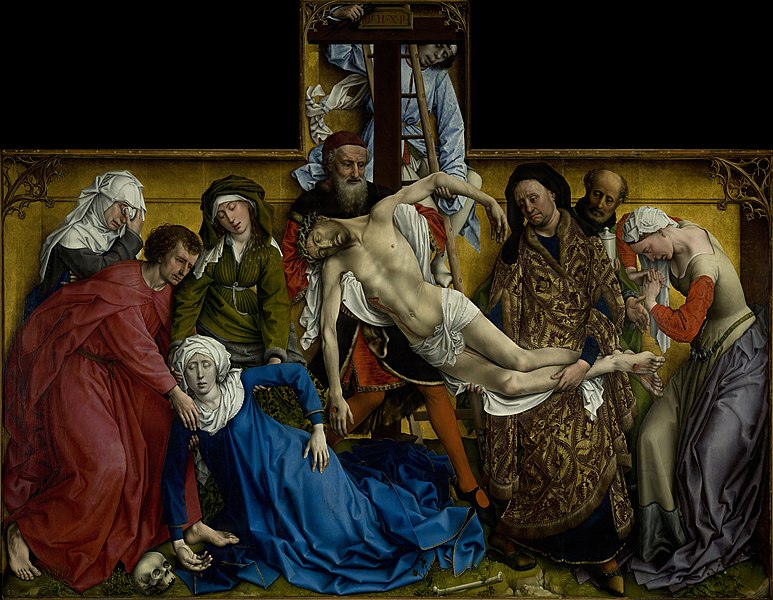It would be easy to write off this off as just another greeting-card version of the familiar Bible story. But look again.
 |
|
Nativity, c. 1420, Robert Campin, courtesy Musée des Beaux-Arts de Dijon |
For more than a century, a body of work was identified as being by the so-called Master of Flemalle. These paintings are now generally attributed to the Belgian painter Robert Campin. These attributions are controversial because the artist didn’t sign or date his output. However, the works in question all bear the hallmarks of Campin’s workshop: keen observation, oil paint rather than egg tempera, and complex perspective.
It would be easy to write off his Nativity, 1420, as just another greeting-card version of the familiar Bible story. But look carefully at the corner post emerging from the collapsing wattle-and-daub wall of the stable. “This is an exact portrait of a specific piece of battered, reused timber,” wrote Martin Gayford. “Every knothole, insect tunnel, split, roughly carpentered joint and variation in the grain of the wood is represented with close-focus precision. Beneath, the footing of the wall has been studied with the same fascination, especially a single, knobbly flint.” From there, let your eyes travel to the perfectly realized landscape in the background.
 |
|
The Annunciation, 1420-25, Robert Campin, courtesy of Museo del Prado |
That wooden post, rather than the crowded cast of characters, is the centerpiece of this extraordinary painting. Why was it so important? It’s a symbol of the cross, but it’s much more than that. Renaissance painters were interested in realism because they recognized that Christianity is, ultimately, grounded in tangible reality. This Nativity was meant to teach something more than just the bare-bones Bible story.
According to Christian doctrine we humans are triune beings, made of body, soul and spirit. We’re supposed to be spirit-led, but our faith never denies the importance of our physical crust. Creation started with a physical world, and moved on to a physical man, made from the dust of the Earth. Only at the end did God breathe the spirit of life into that thing he’d made ‘in his own image.’
 |
|
The two surviving wings of The Werl Altarpiece, 1438, Robert Campin, courtesy of Museo del Prado |
So, ours is a physical world operating on physical laws, which is perhaps why science and industry found such fertile ground in the Christian world. But periodically the natural order of things is upset by miracles. This is not just a New Testament thing; see Shadrach, Meshach, and Abednego in the fiery furnace.
For modern man, miracles are a tough idea to swallow. If you reject the possibility of miracles in general, then the Nativity makes no sense. But that’s a modern rationalist viewpoint, certainly not shared by most of mankind through history.
 |
|
The Marriage of the Virgin, 1420s, Robert Campin, courtesy of Museo del Prado |
Of course, God can do anything he wants to. It wasn’t ‘necessary’ for Jesus to enter the world through a virgin birth, or to be in human form at all. But there’s no reason he couldn’t, either, and Matthew and Luke both said it happened that way.
As important as his paternity is, the Bible narratives actually emphasize his mother. The fact that he was born of woman was the key to Christ’s humanity, and this—that he came down to earth and shared a literal, physical body—is what made his death and resurrection so important. He really was one of us.
Look at the angels at the top. They’re in a different scale, and they have wings. They’re truly otherworldly, because they’re not like us. But that ugly, mewling baby in the foreground? He’s just an ordinary helpless newborn. As he entered the world like mankind, so we have the promise we’ll leave the world like him. We will share the Resurrection. That is the true miracle of the Nativity, and the message of this remarkable painting.








